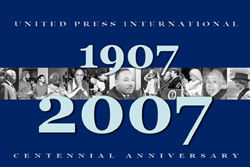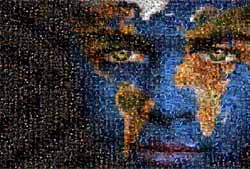1907 - 1910
1911 - 1920
1921 - 1930
1931 - 1940
1941 - 1950
1951 - 1960
1961 - 1970
1971 - 1980
1981 - 1990
1991 - 2000
2001 - Today
|
 |
UPI Archives
Sunday, May 16, 1971
Midnight at Piccadilly Circus
By ROBERT MUSEL
LONDON, May 16, 1971 (UPI) -- It is midnight in Piccadilly, a cold spring night with a faint mist barely burning the neon enticements for rum and beer and vermouth and Coca-cola. The great tide of humanity that daily washes over the center of the city has now finally receded to the residential districts, driven back by the early shutdown of public transport.
Like all tides, it has left beached behind it flotsam and jetsam-in this case shipwrecks of the human race, drug addicts. They began drifting into the area, forming small groups, some 30 minutes ago, turning again and again with terrible fascination to a giant clock advertising the dark brew called Guinness.
About this hour every night they feel they are dying -- some of them may be -- and they pray for midnight and the promise of life for another day.
At midnight the slips they are clutching, prescriptions from the doctors with whom they have registered, can at last be exchanged over the counter of a chemist shop for a daily dose of heroin or cocaine or methadone or whatever is the craving that has them enslaved.
It is one of the "sights" of London no one is proud of. You will not find it listed along with the Tower of London, Westminster Abbey or Big Ben.
The addicts can turn in their prescriptions any hour of the day, but many cannot wait beyond the stroke of midnight, when the new drug period begins. The nameless terrors of the dark are all too real in the sick minds of the score or so young people huddled nightly at the entrance of a deserted arcade or nervously pacing the 30 yards of pavement to one of the few all night drug stores in the city.
The "maintenance dose" which the doctor is supposed to prescribe before his patient takes the cure -- or after he has tried and failed to kick the habit -- is calculated to last only one day to prevent the sale of any surplus. Within minutes after midnight some of the victims hurry from the shop to the toilets of the subway stations nearby to take their fix. They tell of one boy who jabbed the needle through his sweater into his arm, too frantic to wait.
What happens in Piccadilly Circus (and at other all-night drug stores) every midnight is part of the British plan for handling narcotic addiction. Imperfect as it admittedly is, the British believe their system of making drugs legally and cheaply available to genuinely untreatable addicts is working better than any other method does and, if nothing else, at least makes it unprofitable for criminal organizations such as exist in the United States to send out pushers to create more addicts.
For each item on his daily prescription the addict pays 20 pence (48 cents). If he wants more he will have to buy it illegally -- there is a small but significant traffic in illegal drugs, which is why some authorities believe the official figure of 1,466 registered addicts for all of Britain in 1969 is too low. There have been estimates of 2,500 or more -- still small by American standards but up 700 percent from only a decade or so ago.
Some experts, such as Rev. Kenneth Leech, curate of St. Anne's in the high risk drug district of Soho, believe indiscriminate prescriptions of methedrine and amphetamine by a small group of unscrupulous doctors is really responsible for the spread of addiction here. Before their advent in the early 1960s, Britain had 200 to 300 stabilized addicts mostly able to conduct fairly normal lives on maintenance doses of heroin and morphine.
Now the addicts are younger, some of them pathetically young. Dr. N.H. Rathod, a consulting psychiatrist says 25 per cent of all British addicts are under 35; 50 per cent of them under 50. The batch on Piccadilly one recent night all looked to be in their 20s. At 10 minutes to midnight two of them began to quarrel and a girl who intervened was punched in the face for her pains.
Such sudden flares of violence are not uncommon. The night of my midnight watch at Piccadilly Circus, the brief fist fight ended and at the stroke of the hour the addicts started drifting toward the chemist shop in small groups, handed in their prescriptions and came out with little white bags.
Walking alone, a blond boy of about 20, moved spasmodically like a puppet jerked along by unseen strings. As he twitched by me on his doomed journey, I saw on a chain around his neck a replica of the "Ankh." Ironic. The Ankh is the ancient Egyptian symbol for something he would never have. Long life.
Copyright 2007 by United Press International.
|


